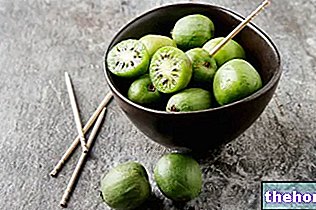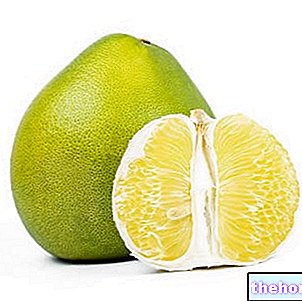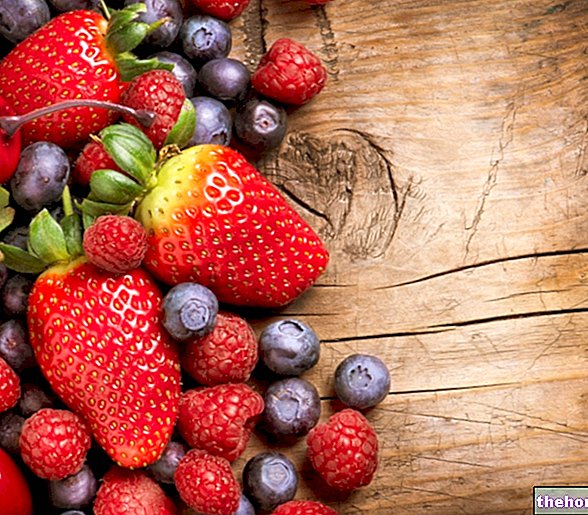Chestnuts and flour
Despite being only marginally used, chestnut flour represents the basic ingredient for the preparation of numerous gastronomic specialties, such as castagnaccio, sweets and polenta.
If on the one hand the chestnut fruit still retains a certain commercial value, on the other, in the context of the Italian food economy, chestnut flour is of marginal importance, subordinated to the production of confectionery specialties typical of some regions.
Chestnut flour is also known as sweet flour and consists of previously dried and finely ground chestnuts.
Chestnut flour has a high calorie content: for this reason, chestnuts and the flour of the same name were - especially in the past - a "very important source of sustenance for many peoples, in particular for the inhabitants of particularly hostile mountain regions. high nutritional value of chestnuts - and derived products - this fruit was known by the term "poor man's bread".
The use of chestnut flour is currently widespread above all in Tuscany and Emilia Romagna.
Chestnuts: general information
Chestnuts are the fruits of Castanea sativa, more commonly called chestnut. It is a mighty tree belonging to the Fagaceae family, which has oblong and serrated leaves, and tasty, floury and edible fruits. The plant also uses wood, which is resistant and strong. The chestnut plant grows mainly in mountainous regions, from 450 to 900 meters.
Chestnut flour: nutritional analysis
Chestnuts are rich in complex carbohydrates: in this regard, chestnut fruits represent an "excellent alternative to cereals.
Chestnut flour is an important food in nutritional terms, thanks to the large percentage of carbohydrates (76.2 g / 100 g of flour) and starches in particular, and the moderate content of proteins (6.1 g / 100 g of product) and fats (3.7 g / 100 g of flour). The remaining 11.4 g consist of water. Chestnut flour is a source of mineral salts, including magnesium, sulfur, potassium (above all), iron and calcium, in addition to the moderate content of vitamins B1, B2, C and PP.
From chestnut to flour
In order to obtain a floury product, the processing of chestnuts is rather simple; nevertheless, the various steps that lead to the creation of the finished product must be carried out very carefully.
The chestnut fruit harvest takes place in October, an ideal period because the urchins containing the chestnuts fall spontaneously from the plant.
After having extracted the chestnuts from the casings, these are placed in huge bales of jute and then taken to the caniccio (small drying room consisting of a fire lit with chestnut wood), for the drying of the fruits. After 20 days, usually, the chestnuts they are subjected to the beating - to clean them from the shell - and, subsequently, to the roasting. The last step is the grinding: the chestnuts are placed in a special water or stone mill, and then through the screening (or sieving) they are selected the chestnut powder particles. In this way, it is possible to obtain a flour with a homogeneous granulometry.
Considerations
Currently, the chestnut is a very expensive fruit: therefore, when the flours are obtained from chestnuts of the highest quality, the value and the price of the raw material also weigh heavily on the finished product. In order to reduce the price of flour, low quality chestnuts are used. By doing so, you run the risk of obtaining a poor product: to overcome these drawbacks, some flours are obtained from crushed chestnuts, separated during the selection intended for direct consumption.
However, there are also chestnut flours at affordable prices and, at the same time, of excellent quality.
The taste of chestnut flour must not be bitter, the color must be clear and the composition impalpable.
Chestnut flour can be consumed by celiacs, as it does not form gluten.
Uses of chestnut flour
As we have seen, chestnut flour represents the cardinal ingredient for the preparation of numerous and varied culinary specialties. The best known confectionery preparation with chestnut flour is undoubtedly the castagnaccio, a typical dessert of the Tuscan-Emilian regions: flour is added water, oil, sugar and dried fruit (pine nuts, raisins, walnuts, etc.), and everything is cooked in the oven.
Chestnut flour is also used for polenta: the preparation is almost the same as for classic polenta with corn flour.
Other desserts include pancakes with chestnut flour and panzerotti.
The use of chestnut flour to make fresh pasta is curious: in general, powdered chestnuts are mixed with other types of flour (generally wheat flour), eggs and water.
Unlike other flours obtained from dried fruit, chestnut flour has a very low fat content: in this regard, some dieticians recommend the use of chestnut flour as a substitute for other flours (eg almonds).
Alice's video recipes on MypersonaltrainerTv
Soft Pizza with Chestnut Flour
Problems with playing the video? Reload the video from youtube.
- Go to the Video Page
- Go to the Video Recipes Section
- Watch the video on youtube
Summary
Chestnut flour: in short
Very important source of sustenance for many peoples of the past, in particular for the inhabitants of mountain regions
- Botanical name: Castanea sativa
- Family of belonging: Fagaceae
- Leaves: oblong and serrated
- Fruits: (chestnuts) tasty, floury and edible
- Carbohydrates: 76.2 g / 100 g of flour
- Protein 6.1 g / 100 g of flour
- Fat: 3.7 g / 100 g of flour
- Water: 11.4 g / 100 g of chestnuts
- Vitamins: b1, b2, c and pp
- Mineral salts: magnesium, sulfur, potassium (above all), iron and calcium
- Harvest of chestnut fruits (October)
- Extraction of chestnuts from sea urchins
- Placing chestnuts in jute bales
- Drying (caniccio)
- Typing
- Roasting
- Grinding
- Screening
- Obtaining of flour with homogeneous granulometry
- Castagnaccio, typical dessert of the Tuscan-Emilian regions: chestnut flour, water, oil, sugar and dried fruit (pine nuts, raisins, walnuts, etc.)
- Polente
- Pancakes and panzerotti
- Fresh pasta
- Excellent alternative to other more caloric flours (eg Almonds)
Other Foods - Fruits Apricots Sour cherries Cashews Pineapple Watermelon Orange Avocado Banana Persimmon Persimmons Apple Chestnuts Cedar Cherries Coconut Watermelon Dates Feijoa Fig of India Figs Strawberries Berries Passion fruit (Maracujà, Granadilla) Jujube Kiwi Raspberries Coconut milk Lemons Almond milk Mango Apples Quinces Pomegranate Melon Blackberries Mustard Medlar Olives Taggiasca Olives Fermented Papaya Pears Peaches Plantains (Cooking Bananas) Pomelo Grapefruit Pink Grapefruit Plums, prunes Fruit juices and fruit juices Grape juice Plums Grapes Sultanas and Raisins OTHER ITEMS FRUIT Categories Food Alcoholics Meat Cereals and derivatives Sweeteners Sweets Offal Fruit Dried fruit Milk and derivatives Legumes Oils and fats Fish and fishery products Salami Spices Vegetables Health recipes Appetizers Bread, Pizza and Brioche First courses Second courses Vegetables and Salads Sweets and Desserts Ice cream and sorbets Syrups, liqueurs and grappas Prepare Basic tions ---- In the kitchen with leftovers Carnival recipes Christmas recipes Light diet recipes Women's, mom's and dad's day recipes Functional recipes International recipes Easter recipes Gluten-free recipes Diabetic recipes Holiday recipes Valentine's Day recipes Vegetarians Protein recipes Regional recipes Vegan recipes




























